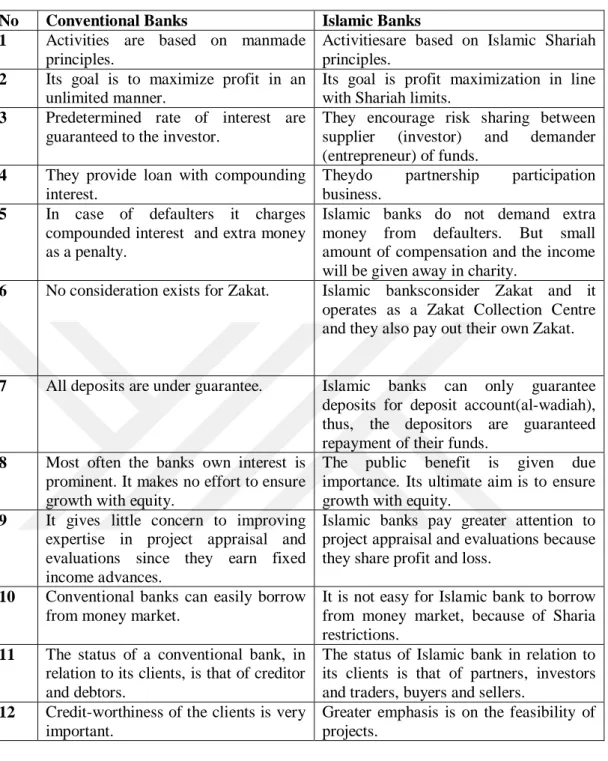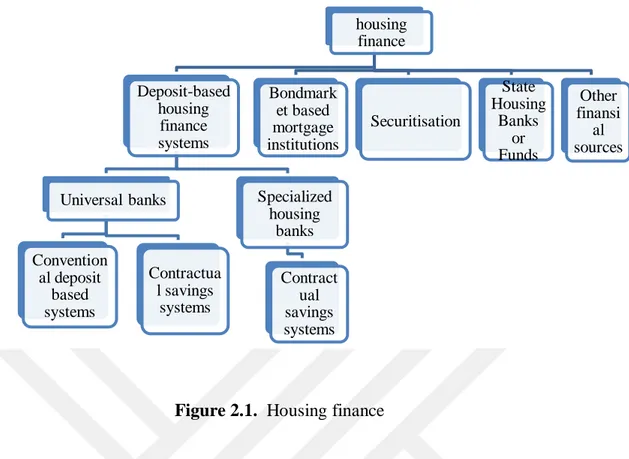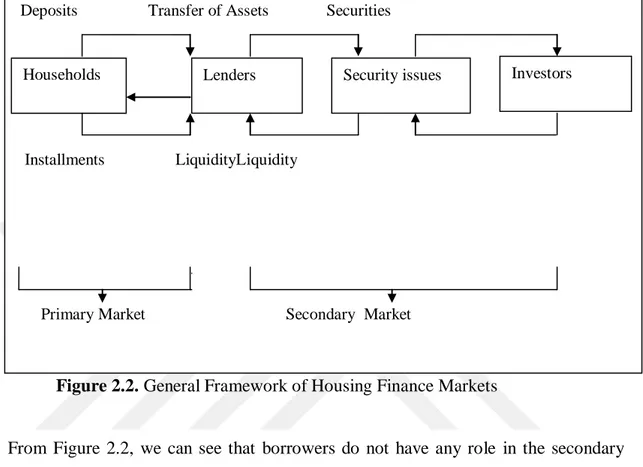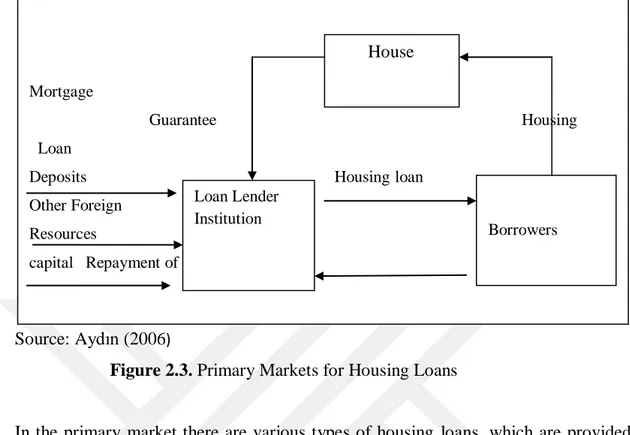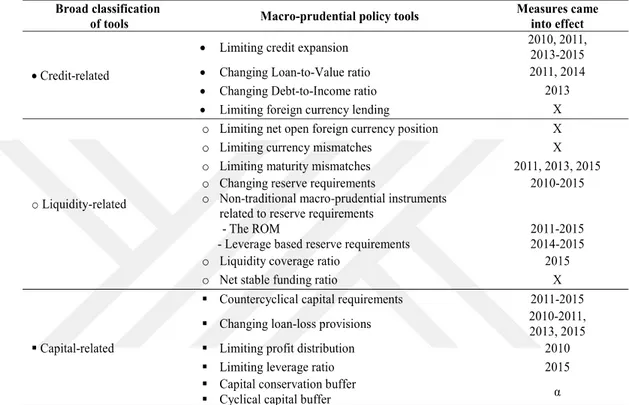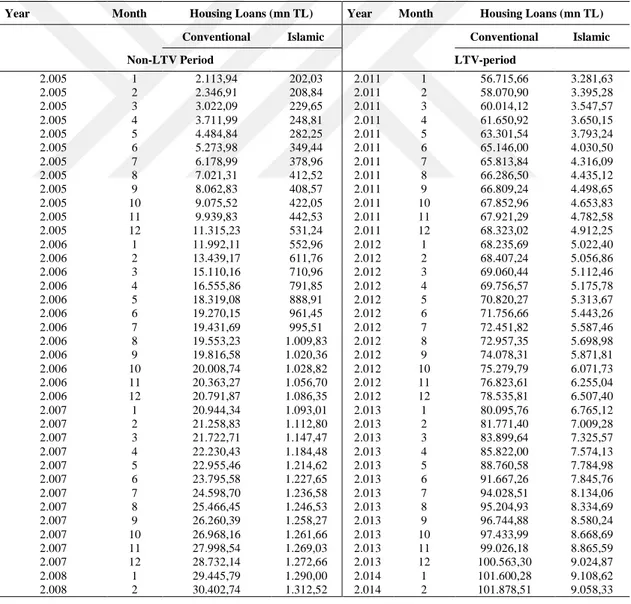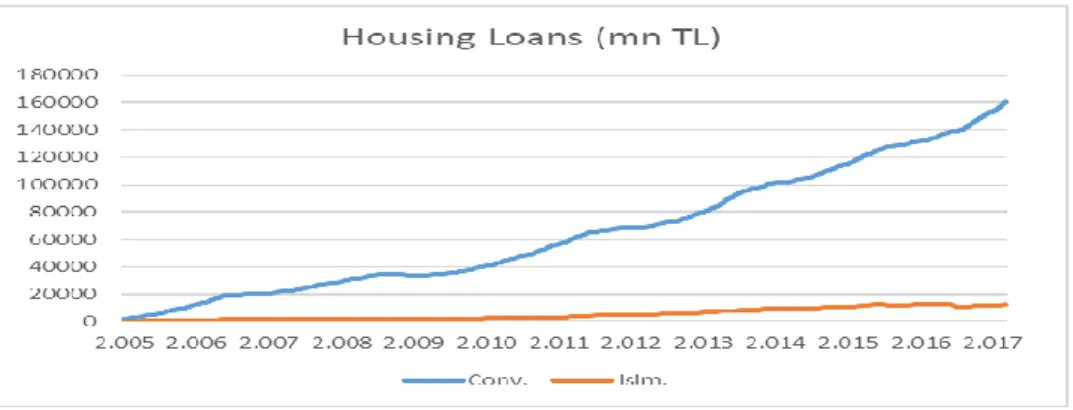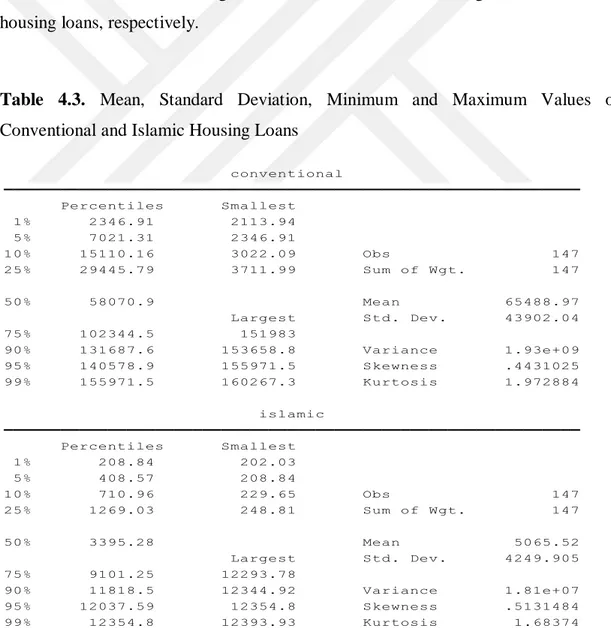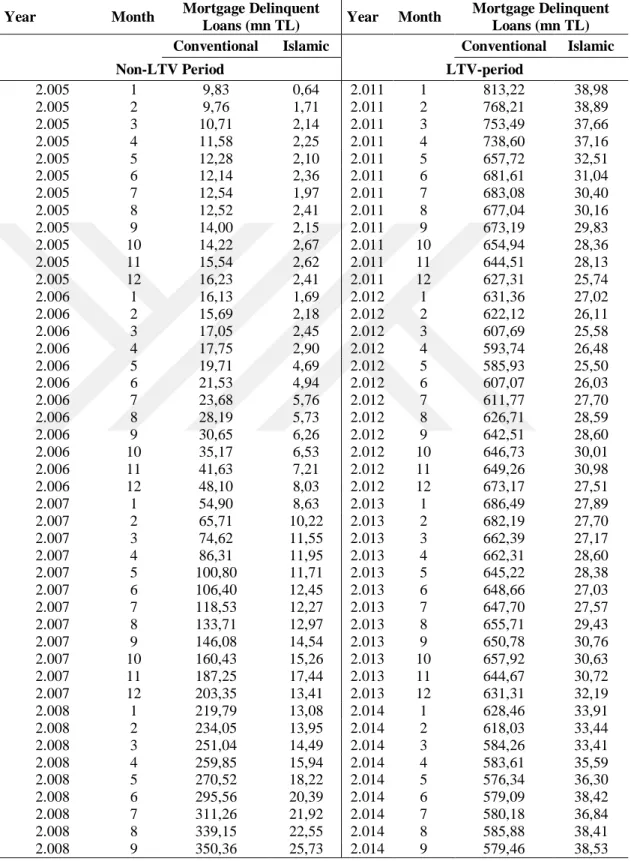ÇANKAYA UNIVERSITY
GRADUATE SCHOOL OF SOCIAL SCIENCES FINANCIAL ECONOMICS
MASTER THESIS
HOUSING FINANCE FOR CONVENTIONAL AND ISLAMIC BANKS
IN TURKISH BANKING SYSTEM
RABAB MILAD ALI
ÇANKAYA UNIVERSITY
GRADUATE SCHOOL OF SOCIAL SCIENCES FINANCIAL ECONOMICS
MASTER THESIS
HOUSING FINANCE FOR CONVENTIONAL AND ISLAMIC BANKS IN TURKISH BANKING SYSTEM
RABAB MILAD ALI
iv
ABSTRACT
Rabab Milad Ali
M.Sc., Department of Financial Economics Supervisor: Assist. Prof. Dr. Burak PIRGAIP
July 2017, 79 pages
As it is known, the global financial crisis through 2008-2009 in the world had also affected Turkish economy. This crisis pushed Turkey to implement the macro-prudential policies to avoid potential future crises. In that respect,this thesis aims at examining the effectiveness of LTV policy in reducing systemic risk arising from property markets, and to examine if it has the same impact for conventional and Islamic banks in Turkey. For this purpose, housing finance in conventional and Islamic banks are reviewed, and impact ofLTV policy in conventional and Islamic banks in Turkey is explained. Further, the relationship between the amount of housing loans and their delinquencies in conventional and Islamic banks and LTV policy is analyzed with tests of difference, Chow test and time-series regressions between the non-LTV period and LTV-period. These tests show that the response of the amount of housing loans and mortgage delinquency to LTV interventionin conventional banks is greater than in Islamic banks.
Keywords: Conventional and Islamic Banks, Housing Finance, Loan To Value
v
ÖZ
Rabab Milad Ali
M.Sc.Finansal Ekonomi Bölümü
Tez Yöneticisi: Assist. Yrd. Doç. Dr. Burak PIRGAIP July 2017, 79sayfa
Bilindiği üzere, 2008-2009 küresel finans krizi Türk ekonomisini de etkilemiş; ileride karşılaşılabilecek potansiyel krizlerin önlenebilmesini teminen birtakım makroihtiyati politikaların benimsenmesini gerektirmiştir. Bu kapsamda, tez çalışmasında söz konusu politikalardan biri olan kredi-değer oranının gayrimenkul piyasalarından kaynaklanan sistemik risklerin azaltılmasındaki etkinliğinin geleneksel ve İslami bankalar açısından karşılaştırmalı olarak incelenmesi amaçlanmıştır. Buna göre, konut finansmanı sistemi geleneksel ve İslami bankalar için ayrı ayrı irdelenmiş ve söz konusu sistemde kredi-değer oranına ilişkin düzenlemelerin etkisi ortaya konmuştur. Çalışmada, geleneksel ve İslami bankalar tarafından kullandırılan konut kredilerinin miktarı ve takibe dönüşüm miktarları ile kredi-değer oranı politikası arasındaki ilişkiler fark testleri, Chow testleri ve regresyon analizleri yordamıyla açıklanmıştır. Kredi-değer oranının uygulanmadığı dönemler ile uygulandığı dönemlerin söz konusu testlerle mukayese edilmesi sonucunda elde edilen bulgular, kredi değer oranı düzenlemesinin konut kredilerinin miktarı ve takibe dönüşüm miktarları üzerindeki etkilerinin geleneksel bankalarda İslami bankalardakinden daha anlamlı olduğunu göstermektedir.
Anahtar Kelimeler: Geleneksel ve İslami bankalar, Konut Finansmanı, Kredi/Değer
vi
ACKNOWLEDGEMENTS
Firstly, I would like to express my deepest gratitude to my supervisor Dr. Burak Pirgaipfor his guidance, advice, criticism, encouragements, patience and insight throughout the research.
I would also like to convey my heartfelt thanks to my family who have been very understanding and supportive throughout the course of my studies. Thanks for their endless love and support that guided me through the hard times when I was studying away from home.
vii
TABLE OF CONTENTS
STATEMENT OF NON PLAGIARISM... iii
ABSTRACT... iv
ÖZ………... v
ACKNOWLEDGEMENTS……… vi
TABLE OF CONTENTS……….. vii
LIST OF FIGURES………... x
LIST OF TABLES……… xi
INTRODUCTION……….. 1
1. CONVENTIONAL AND ISLAMIC BANKING... 2
1.1. Conventional Banking... 2
1.1.1. A Brief History of Conventional Banking……… 2
1.1.2. Conventional Bank‟s Definition..………. 2
1.1.3. Sources and Uses of Funds in Conventional Bank……… 3
1.1.3.1. Sources of Funds in Conventional Banks……… 3
1.1.3.2. Uses of Funds in Conventional Banks……… 4
1.2. Islamic Bank ………..………... 5
1.2.1. A Brief History and Growth of Islamic Banking and finance... 5
1.2.2. Islamic Bank‟s Definition……… 6
1.2.3. Principles of Islamic Banking(the Basis)……… 8
1.2.4. Sources and Uses of the Funds in the Islamic Banks………… 10
1.2.4.1 Sources of Funds in Islamic Banks……… 10
1.2.4.2 Uses of Funds in Islamic Banks……… 11
1.3. Similarities and Differences between Islamic and Conventional Banks... 12 1.3.1. Similarities……… 12
1.3.2. Differences……… 12
1.3.2.1. Features of Conventional and Islamic banks... 12
viii
1.3.2.3. Financing and Investment……… 14
2. HOUSING FINANCE……….… 19
2.1. Meaning of Housing Finance………... 19
2.2. Major Elements of Housing Finance………. 19
2.3. Five Housing Financing Systems………. 20
2.4. Mortgage……… 21
2.5. Housing Financing Markets……… 22
2.5.1. Primary Market for Housing Loans... 22
2.5.2. Secondary Market for Housing Loans... 23
2.6. Housing Finance Systems in Turkey... 24
2.6.1. Non-Institutional Structure of Turkish Housing Finance System 25 2.6.2. Institutional Structure of the Turkish Housing Finance System 25 2.6.2.1. Social Security Institutions... 25
2.6.2.2. Real Estate Bank………..………... 26
2.6.2.3. Commercial Banks……… 26
2.6.2.4. Real Estate Investment Trusts(REITs)………. 27
2.7. Housing Finance in Conventional Banks... 27
2.7.1. Fixed Rate Mortgage……… 27
2.7.2. Adjustable Rate Mortgage………... 27
2.7.3. Hybrid Mortgage……….. 28
2.8. Islamic Housing Finance Product Concepts……….. 29
2.8.1. Murabahah……… 29
2.8.2. Ijara Wa Iqtina(Lease and Purchase)………. 30
2.8.3. Diminishing Musharakah………. 30
2.9. Global Financial Crisis 2007-2008……… 31
2.9.1. Common Causes……….. 31
2.9.2. New Causes……….. 32
3 BANK REGULATIONS……… 34
3.1. Regulate Banks……….. 34
3.1.1. Protection of Depositors………... 34
3.1.2. Monetary and Financial Stability………. 35
ix
3.1.4. Consumer Protection……… 37
3.2. Risks Involved in Mortgages………. 37
3.2.1 Default Risk……… 38
3.2.2. Interest Rate Risk………. 38
3.2.3. Prepayment Risk……….. 39
3.2.4 Liquidity Risk……… 39
3.3. Most Common Regulatory Instruments……… 40
3.3.1 Loan To Value Ratio……… 42
3.3.2 Calculate the Loan To Value Ratio………. 42
4. LTV INTERVENTION ON CONVENTIONAL AND ISLAMIC BANKS: AN EMPIRICAL ANALYSIS……….. 44 4.1. A Brief History of the LTV policy in Turkey………... 45
4.2. Empirical Analysis of the Impact of LTV policy in Conventional and Islamic Banks in Turkey……… 48 4.2.1. Descriptive Statistics……… 49
4.2.2. Inferential Statistics………. 55
4.2.2.1. Tests of Difference between the non LTV Period and LTV Period……… 55 4.2.2.2. Testing for Structural Break………. 60
4.2.2.2.1. Testing Structural Break: Chow Test……… 62
4.2.2.3. A Time Series Regression to Measure the Impact of LTV Regulation………. 68 5. CONCLUSION... 72
APPENDIX: Glossary and Transliteration………... 75
x
LIST OF FIGURES
Figure 2.1. Housing Finance……….. 21
Figure 2.2. General Framework of Housing Finance Market……… 22
Figure 2.3. Primary Markets for Housing Loans………... 23
Figure 2.4. Operation of Secondary Market with a Conduit……….. 24
Figure 4.1. Housing Loans Granted by Conventional and Islamic Banks…. 50 Figure 4.2. Mortgage Delinquency in Conventional and Islamic banks…… 53
xi
LIST OF TABLES
Table 1.1. Features of Conventional and Islamic Banks……….. 13
Table 4.1. Macro-Prudential Policy Tools Used in Turkey 2010-2015…... 46
Table 4.2. Housing Loans Granted by Conventional and Islamic Banks... 49
Table 4.3. Mean, Standard Deviation, Minimum and Maximum Values of
Conventional and Islamic Housing Loans... 51
Table 4.4. Mortgage Delinquent Loans in Conventional and Islamic
Banks... 52
Table 4.5.
Mean, Standard Deviation, Minimum and Maximum Values of Mortgage Delinquent Conventional and Islamic Housing Loans...
54
Table 4.6. Test of Differences Regarding the Amount of Housing Loans
in conventional and Islamic banks... 55
Table 4.7. Test for Differences for Mortgage Delinquent Housing Loans... 57 Table4.8. The Short-Term Impact of LTV Intervention (non-LTV period) 58
Table4.9. The Short-Term Impact of LTV Intervention (LTV period)... 60
Table 4.10. Data of Housing Price Index (HPI)... 61
Table 4.11. Chow Test with Respect to Model (3) for Conventional Banks.. 64 Table 4.12. Chow Test with Respect to Model (4) for Conventional Banks 65
Table 4.13. Chow Test with Respect to Model (3) for Islamic Banks…….. 66
xii
Table 4.15. Time Series Regression for Conventional Banks in terms of
amount of housing loans... 69
Table 4.16. Time Series Regression for Conventional Banks in terms of
mortgage delinquent housing loans... 70
Table 4.17. Time Series Regression for Islamic Banks in terms of amount
of housing loans... 70
Table 4.18. Time Series Regression for Islamic Banks in terms of
1
INTRODUCTION
Banks play significant role in the economy through providing several services and facilities to individuals and communities. One of the important facilities that provided by banks is housing finance.
In this study, we are going to explore how housing is financed by conventional and Islamic banks in Turkey. There are different points in these banking facilities, however almost same rules and regulations apply for both. In that respect, it is worthwhile to find out whether or not these rules and regulations impact both banks in the same way. We intend to analyze a macroprudential tool, i.e., loan to value (LTV) in order to compare both type of banks.
This study will be divided into four chapters. Chapter one will be about conventional and Islamic banks, their history, definitions, resources and uses of funds, also will discuss and show the similarities and differences of these banks. Chapter two will define and explain how housing is financed in conventional and Islamic banks, in addition will show how financial crisis affects both banks. Chapter three will shed light on the regulationsthat use by both banks to control the finance of housing and will focus on LTV regulation. Chapter four will measure the impact of LTV ratio on conventional and Islamic banks in Turkey. Chapter five will conclude.
2
CHAPTER 1
Conventional and Islamic Banking
1.1.Conventional Banking
1.1.1. A Brief History of Conventional Banking
First occurrence of banks goes back to ancient times in both Babylonia and Assyria where merchants provided loans to farmers. Then, in ancient Greece and during the Roman Empire, lenders provided loans with novel means: the exchange of currency and the acceptance of deposits. The presence of money lending activity was also shown by archaeology from this period in ancient India and China.
Conceptually, banking dates back to Middle Ages and to Italian cities such as Venice, Florence and Genoa in early renaissance period. Banking was dominated by the Peruzzi and Bardi families in the fourteenth century. On the other hand, the Medici bank,founded by Giovanni Medici in 1397, was about the most famous Italian bank.
Also in Amsterdam in the sixteenth century and in London in the seventeenth century, banking extended through Europe as significant innovations took place. Through the twentieth century, informational technology lead radical changes to the way banks operated, and they enjoyed a dramatic increase in size and gained geographic spread(Cruz, 2016).
1.1.2. Definitions of Conventional bank
Several definitions have been given to describe a conventional bank, which include the viewpoint of a classical or modern approach.
3
From a classical point of view, it can be defined as a financial intermediary between suppliers and demanders of funds where the formerwants to keep and develop funds for future profits, and the latterneeds funds for investment or operations(Akrani, 2011).
Conventional bank is also known as "a financial institution and a financial
intermediary that accepts deposits and channels those deposits into lending activities, either directly or through capital markets. A bank connects customers that have capital deficits to customers with capital surpluses”(Meena, 2016).
From a modern point of view, it is defined as a financial institutionthat accepts deposits in order to support the national economy for example in terms of development of savings and investments, including contributing to the creation of projects and what request of banking, commercial and financial operations as defined by the central bank(Heffernan, 2005).
1.1.3. Sources and Uses of Funds in Conventional Banks
1.1.3.1. Sources of Funds in Conventional Banks
Financial sources occur in the liability side of bank‟s balance sheet and can be divided into three groups:
Capital: Capitalis the net worth that constitutes the difference between a bank‟s
assets and liabilities. Capital is classified as follows: - Paid-up capital.
- Revenue Reserves.
Deposit: Bank deposits are funds that are placed into bank by depositors for
safekeeping. Conventional banks mainly depend on all kinds of deposits as sources of funds. Deposits of bank are liabilities and should be returned to the owners on demand. There are many types of deposits such as:
4
- Current deposits (demand deposits). - Saving deposits.
- Fixed deposits.
Borrowings: Sometimes conventional banks resort to borrowing from Central Bank
and other banks or institutions to raise funds. But, by nature, these sources should only be used when the bank is unable to meet the commitments of its own(Stephen D. Simpson, 2015).
A. Borrowing from the central bank.
B. Borrowing from over-the-counter market: - Interbank market.
-Money market. - Repo arrangements.
C. Borrowing from international markets: - Bonds issued by the bank.
1.1.3.2. Uses of Funds in Conventional Banks
There are two fundamental uses of funds in conventional banks: lending and investment.
Lending: Banks employ most of their funds into providing loans and advances to
their clients, and in return get interest income. Loans and advances are provided to the commercial and industrial businesses, agriculturists, housing building companies and individuals. Conventional banks provide loans and advances in various forms such as: call loans, overdrafts, cash credit, loans, housing finance loans, and discounting bills of exchange.
Investments:Conventional banks generally investin fixed income securities and
shares in the open market. The bank can earn money as dividends on its equity investments or it may earn fixed or variable interest on bonds. Banks allocate their fund in the following types of investment:
5
- Government securities.
- Provincial and local government bonds. - Corporate securities.
- Foreign governments‟ bonds. - Others securities (Althea, 2015).
1.2.Islamic Banking
1.2.1. Chronology of Islamic Banking and Finance
Islamic banking has recently become an alternative, if not a competitor, to conventional banking and is experiencing a fast growth in not only in Muslim countries but also in non-Muslim ones as well. Some critical milestones in this growth period are summarized as follows:
- Before-1950s.: Barclays Bank opens its Cairo branch to arrange financial
transactions with respect to construction of the Suez Canal in 1890s. Operations of the bank were challenged and criticized by Islamic scholars due to interest considerations. As the criticism became widespread in other Muslim countries, Islamic scholars declare that any form of interest is deemed to be “riba” which is prohibited.
-1950s–60s:Theoretical studies in Islamic economics were initiated in 1953. In that
respect, the first description of an interest-free bank was offered by Islamic economists based on either two-tier mudarabah or wakalah, which are both described in the following sections. Mitghamr Bank in Egypt and Pilgrimage Fund in Malaysia begin operations among 1950s–60s.Mitghamr Bank Local Savings Bank is the first Islamic bank ever. The bank operated on the basis of Shari‟ah law and flourished because it was able to meet the savings and credit requirements of its customers in an Islamic way. It was followed, in 1967, by the Nasir Social Bank as the first social bank under Shari‟ah principles.
6
- 1970s: The Dubai Islamic Bank (1975) in Dubai, the Islamic Development Bank in
Saudi Arabia (1975), the Faisal Islamic Bank in Egypt (1976) and the Faisal Islamic Bank of the Sudan (1977) in Sudan were established. An International Association of Islamic Banks was established in 1977 in Saudi Arabia so as to coordinate Shari‟ah principles between Islamic banks in several countries. Following that, the Jordan Islamic Bank (1978), the Jordan Financial and Investment Bank (1978), the Jordan Islamic Bank (1978), the Islamic Investment Company Ltd in the United Arab Emirates (1978) and Kuwait Finance House (1979) were founded.
- 1980s: The first Islamic bank, Islamic Bank of Investment and Development, was
established in Luxembourg, which is a non-Muslim country, in 1980.The Islamic Research and Training Institute is established in 1981.Banking systems in the Iran, Pakistan, and Sudan are converted to an interest-free banking system. Countries like Bahrain and Malaysia promote Islamic banking parallel to the conventional banking system. Other Islamic banks were established in Abu Dhabi, Qatar, Mauritania, Iraq and etc. between 1980-1986.
- 1990s:Accounting and Auditing Organization of Islamic Financial Institutions, was
established. The market witnessed Islamic equity funds and Islamic insurance products. The Dow Jones Islamic Index and the FTSE Index of Shariah -compatible stocks are developed.
- 2000–the present:In 2002, Islamic Financial Services Board is established to
promote Islamic banking (Van Greuning & Iqbal, 2008; Venardos, 2012) and to deal with supervisory, regulatory and corporate governance issues.Sukuks, i.e. Islamic bonds, were launched and the United States and United Kingdom start to offer Islamic mortgages.
1.2.2. Islamic Banking
Some have argued that the only difference between Islamic banking and conventional banking is the word “interest” and Islamic banks are structured in a way
7 where the seller changes ownership to the bank and then the bank sells it to the ultimate buyer(Iqbal & Llewellyn, 2005).
The Organization of Islamic Conference defined Islamic banking as “a financial
institution whose statutes, rules and procedures expressly state its commitment to the Principles of Islamic Shariah and to the banning of the receipt and payment of interest on any of its operations”(Hassan & Lewis, 2009).
Islamic banks are the banks that do all necessary banking operations for different transactions and invest the money in all aspects of the various and diverse economic activity, in accordance with the provisions of Islamic Shariah law(El-Gamal, 2006).
From the definitions above, one can understand that trade in goods and services is not the essential purpose for which Islamic bank was created. Rather it was intended to provide same services offered by conventional banks to the Muslim world, so that Muslims can avoid paying or taking interest and at the same time can find profit on his savings and financing of his business. In addition, previous definitions stand for the following most important goals of Islamic banks:
- To make an Islamic alternative to remove hardship on Muslims.
- To comply with the provisions of Islamic law in banking operations carried. - To provide necessary funds for business owners in a legitimate way for the
purpose of support economic and beneficial social projects.
- To encourage investment by creating opportunities and numerous formats for investment commensurate with individuals and companies.
- To achieve a real solidarity between suppliers and users of funds, by linking depositors' return with the results of employing money by these users whereby they may have a profit or loss.
- To develop ideological and moral values in the transaction and install them among workers and clients.
- To help clients in the performance of Zakat on their money, and do their part to participate in economic and social development(Norrahman, 2014).
8
1.2.3. Principles of Islamic Banking
In this section, a brief summary of the principles that drive the activities of Islamic banks is provided.
Prohibition of Riba (Interest)
Riba is any kind of monetary or non- monetary increase of the principal in a loan that must be paid by the borrower to the lender along with the principal as a condition1of the loan or for an extension in its maturity. According to a consensus of fuqaha‟ (Islamic jurists), riba has the same meaning as the modern concept of interest in conventional banking(Iqbal & Molyneux, 2005).The Holy Qur'an ban the taking and the paying riba (interest) as it is common in conventional banking, so investors must be aware by other means. Also it is stated in the Holy Qur‟an that those who disregard the prohibition of interest are at war with God and His Prophet Muhammad(Kabir Hassan, 1999).The following verses of the Holy Qur‟an explicitly prohibit riba:
“And for their taking riba although it was forbidden for them, and their wrongful appropriation of other people‟s property. We have prepared for those among them who reject faith a grievous punishment.”Surah al-Nisa‟, verse (4: 161).
“That which you give as riba to increase the people‟s wealth increases not with God; but that which you give in charity, seeking the goodwill of God, multiplies manifold.”Surah al-Rum, verse (30: 39).
“O believers, take not doubled and redoubled riba, and fear Allah so that you may prosper. Fear the fire which has been prepared for those who reject faith, and obey Allah and the Prophet so that you may get mercy.”Surah Al-e-Imran, verse (3: 130). “Those who take riba shall be raised like those who have been driven to madness by the touch of the Devil; this is because they say: „Trade is just like interest‟ while God has permitted trade and forbidden interest. Hence those who have received the
1
Thus if the borrower give any excess without compact and without the existence of a custom or rule that force him to give such excess, is not considered as a riba.
9 admonition from their Lord and desist, may keep their previous gains, their case being entrusted to God; but those who revert, shall be the inhabitants of the fire and abide therein forever.”Surah al-Baqarah, verse (275).
“And if the debtor is in misery, let him have respite until it is easier, but if you forego it as charity, it is better for you if you realize.”Surah al-Baqarah, verse (280).
Verses of Surah al Baqarah above, not only describe the prohibition of riba, but also give a comprehensive principle for determining whether or not a transaction includes riba(Ayub, 2009).
The Prohibition of Gharar and Maysir
Any transaction should be free from Gharar which stands for uncertainty, risk or speculation. Parties should have perfect knowledge of deferred payments and deliveries as a result of their transactions. Under Islam deferral of payment is an acceptable type of debt, in contrast to predetermined debt in conventional finance. Further, profit cannot be predetermined by parties. Protecting the weak from exploitation was the reason behind forbidding of gharar. Thus, futures and options, expected to be very risky, are supposed to be prohibited (Kettell, 2011).
Maysir, however, means gaining something valuable easily without making any effort for it or without paying an equivalent indemnification for it or without taking responsibility against it, by way of a game of chance.Gambling and wagering as defined by the word “Maisir” in the Holy Qur‟an are prohibited(verses 2: 219 and 5: 90, 91)(Ayub, 2009).
Haram/Halal
Islamic financial activities operate under a strict code of „ethical investments‟. There are some activities and items that cannot be financed by Islamic banks since these are forbidden (that is haram) in Islam. For example, it is haram to deal in pigs and their byproducts in all forms or trade of alcoholic beverages. Moreover, as the fulfillment of material needs assures a religious freedom for Muslims, Islamic banks are urgedto
10
give primacy to the production of essential goods and services that meets the requirements of the Muslim community. From a religious viewpoint it is inadmissible to participate in the production and marketing of luxury activities, since it is “Israf wa traf” (wastefulness and luxury) when Muslims suffer from a lack of food, shelter, education and health(Hassan & Lewis, 2009).
Shari’a board
A Religious Supervisory Board is expected to be established by Islamic banks to ensure that all of their practices and activities are in accord with Islamic law. The board consists of independent Muslim jurists who are involved in auditing existing contracts, inspecting all new contracts, and approving new developments of product. Also,the collection and distribution of zakat is monitored by Shari‟a Board. This governance structure is completely different than the one in any conventional bank(Hassan & Lewis, 2009).
1.2.4. Sources and Uses of Funds in Islamic Banks
1.2.4.1.Sources of Funds in Islamic Banks
Sources of funds in Islamic banks can be classified in two groups as internal and external sources.
Internal Sources
They represent the capital, reserves and retained earnings. Capital is very important in Islamic banks where it represents the safety valve that is used to protect bank from the expected losses. Moreover, it is the basic source of funds used to start the operations. Capital is safety cushion forclients.
External Sources
Islamic bank depends on deposits as main resources that can be used in mobilizing and attracting the savings from individuals. Deposit is an agreement for an Islamic bank where itreceives anamount of money that is paid by depositor in one of the
11
different means of payment. Deposits in the Islamic banks can be categorized as follows:
- Current Accounts (term or demand deposit). - Saving Accounts.
- Investment Accounts(Elseoudi et al., 2012).
1.2.4.2. Uses of funds in Islamic banks
Islamic banks use funds by offering financing facilities in order to generate revenue. Financing facilities have to be done based on the Islamic concepts accepted by the Islamic bank Shariah Council. Islamic banks generally employ following concepts:
Murabaha (Cost Plus / Mark up): Murabaha is the best mode that Islamic banks prefer to use. Briefly, the bank provides fundsfor the purchase of goods by buying it on behalf of its customer and adding a profit mark-up before reselling it to the customer on a cost-plus basis contract.
Ijara and Ijara Wa Iqtina (Leasing): Under Ijara, banks purchase machinery or equipment and lease it out to their clients, where they can buy this machinery at the end of leasing period. Periodical payments include rental for the use of these goods towards the purchase price.
Qard Hasan (benevolent loans): Qard Hasan is the zero return type of loan that the Holy Quran motivates Muslims to make obtainable to those who need them. Just the principal must be repaid to the bank by the borrower, but the borrower can pay additional amount to the bank as gift.
In addition, Islamic banks use some other modes of finance such Bai‟ muajjal (deferred payment), Bai‟ salam (prepaid purchase), Istisna (manufacturing) and Mudaraba (Alfatakh, 2016).
12
1.3. Similarities and Differences between Islamic and Conventional Banks
1.3.1. Similarities
Both banks provide many similar services to their customers such as: - Acceptance of deposits.
- Cheque collection and payment.
- Money transfers and collections on behalf of the customers.
- Consultancy. Banks hire financial, legal and market experts, who provide advices to customers relating to investment, trade, industry, income, tax etc. - Marketable securities trading on behalf of customers.
- Providing services of keeping, cashing and transportation of money and values.
- Foreign currency exchange. Banks deal with foreign currencies, as requested by customer, banks exchange foreign currencies with local currencies.
- Money transfers and collections on behalf of the customers.
- Bank Guarantee. Both banks offer bank guarantees to customers. When customers have to deposit certain fund in governmental offices or courts for specific purpose, bank can present itself as the guarantor for the customer, instead of depositing fund by customers(Alfatakh, 2015).
1.3.2. Differences
This section will shed light on the differences between both banks in accordance to their sources and uses of fund, but before that it is better to know the features of conventional and Islamic banks.
1.3.2.1. Basic Characteristics of Conventional and Islamic Banks
According to Wahab et al. (2014) characteristics of conventional and Islamic banks can be portrayed as follows:
13
Table 1.1. Certain Characteristics of Conventional and Islamic Banks
No Conventional Banks Islamic Banks 1 Activities are based on manmade
principles.
Activitiesare based on Islamic Shariah principles.
2 Its goal is to maximize profit in an unlimited manner.
Its goal is profit maximization in line with Shariah limits.
3 Predetermined rate of interest are guaranteed to the investor.
They encourage risk sharing between supplier (investor) and demander (entrepreneur) of funds.
4 They provide loan with compounding interest.
Theydo partnership participation business.
5 In case of defaulters it charges compounded interest and extra money as a penalty.
Islamic banks do not demand extra money from defaulters. But small amount of compensation and the income will be given away in charity.
6 No consideration exists for Zakat. Islamic banksconsider Zakat and it operates as a Zakat Collection Centre and they also pay out their own Zakat.
7 All deposits are under guarantee. Islamic banks can only guarantee deposits for deposit account(al-wadiah), thus, the depositors are guaranteed repayment of their funds.
8 Most often the banks own interest is prominent. It makes no effort to ensure growth with equity.
The public benefit is given due importance. Its ultimate aim is to ensure growth with equity.
9 It gives little concern to improving expertise in project appraisal and evaluations since they earn fixed income advances.
Islamic banks pay greater attention to project appraisal and evaluations because they share profit and loss.
10 Conventional banks can easily borrow from money market.
It is not easy for Islamic bank to borrow from money market, because of Sharia restrictions.
11 The status of a conventional bank, in relation to its clients, is that of creditor and debtors.
The status of Islamic bank in relation to its clients is that of partners, investors and traders, buyers and sellers.
12 Credit-worthiness of the clients is very important.
Greater emphasis is on the feasibility of projects.
1.3.2.2.Deposits
Both types of banks collect deposits from savers regardless of the banking scheme. The distinction lies in predetermined return. In conventional banks, return is predetermined as an interest rate offered to the depositors while Islamic banks cannot offer fixed or predetermined return. It is variable on profit and loss basis(Hanif,2014). As mentioned earlier, Islamic banks operate deposits into current,
14
savings and investment accounts. In current accounts, Islamic bank does not pay any return and are only used for liquidity purpose, since there are no profits to share. In saving accounts holders may get a return from Islamic banks as hiba for their deposits. An investment accounts holder receives a higher return, but they also share in the risk of losing money if the bank makes a loss (Hassan & Lewis, 2009).
The difference from Islamic bank deposits is that conventional pay a fixed and predetermined interest to depositors at the end of term whenever they make profit or loss. The depositors have nothing to do with the loss of bank (Kesowani, 2012).
1.3.2.3. Financing and Investment
Both banks provide funds in order to obtain return.But, conventional banks provide loan for an interest which Islamic banks are prohibited to do. Islamic banks can make profit only on investment. Three types of loans issued by conventional banking are overdrafts, short-term loans and long term loans. Islamic banks can only offer interest free loans(Qarz e Hasna) for any emergency, even so they can do business by providing the desired asset to customer (Hanif, 2014).
-overdraft / credit cards
In conventional banks customers get the facility of overdrawing from its account on interest. Using credit card is one of its forms where the bank determines the overdrawing for customer. By using credit card a customer does not have to carry cash to meet its need. Islamic banks cannot offer such a facility of financing except in the form of Murabaha (where in Murabaha Islamic bank hand over the required commodity and not the cash). However, needs that meet by facility is provided through debit card by which a customer is able to use his card if his account carries credit balance. In conventional banks a customer has to pay interest when he uses the facility but under Murabaha only profit is due when customers receive the commodity from Islamic bank. Otherwise, conventional banks charge more interest from customers for the extra period of default while under Murabaha in Islamic banks extra charging is forbidden.
15
Under conventional banks customers can come into a new covenant and benefit from the opportunity of rescheduling to pay interest for extensive period, which is not the same in Islamic banks. Under Murabaha, Islamic banks have the right to claim only the original receivable amount concurrent in initial contract. Also, another practical matter under Murabaha in Islamic banks is how to deal with intentional defaulters. In Islamic banks, there are various options to deal with intentional defaulters which includes putting them in black list and do not provide any more financing facility to them, stipulating in the contract that defaulter have to pay all installments at once, stipulating in the contract a punishment will be imposed on defaulter but this will use for charity since it cannot be the same as income of Islamic banks(Hanif, 2014).
-short term loans
Conventional banks provide short-term and medium-term loans to customers to meet working capital requirements of firms. Islamic banks use Murabaha to invest in inventory. Also, Islamic banks provide participation term certificates to meet day to day expenses of business where profit of a specific period is divided by Islamic banks on a proportional basis. However, because of risk involved for Islamic banks in the transaction using participation term certificates for financing is not as easy as a short-term loan from conventional banks. Firm that wants to get short-term facility/business to the gratification of investor. Under Islamic banks there is still no arrangement to the working capital needs of nonprofit organizations. Also, personal consumption loans are not provided by Islamic banks, whatever any individual of sound financial position can obtain anything for his personal use under Murabaha financing where Islamic banks add a certain percentage of profit on cost.
Murabaha is asset based on financing which can be requested by anyone from Islamic banks for provision of an asset to be used for halal (lawful) purposes(Hanif, 2014). In default case, under conventional banks an idlers customers have to reschedule their debt, generally at a higher rate. The aim of imposing this extra interest cost on the customer is to motivate him to pay on time. While under Islamic banks in the Murabaha agreement, banks can stipulate that in case of customer‟s delay in payment without veritable reason, all residual installments will be due; so,
16
the customers will have to try to be more regimental. Islamic banks under its contracts in case of default customer should pay to charity. But for really unable customer it will not be charged any such penalty (Ayub, 2009).
- Medium to long-term loans
Purchase or building of fixed assets by firms to substitute or extend the existing assets can be provided by medium to long-term loans. Under Islamic banks, Murabaha, Bai Muajjal (credit sale) and Istasna (forward selling agreement) are used to fulfill individuals and firms requests. There is one more financing option, which is profit sharing under Musharaka (partnership) and Mudaraba (type of partnership) for long-term financing. Though financing under Murabaha, Istasna and Bai Muajjal is very similar to loans in conventional banks with the only difference which is providing of asset rather than cash to customer however differences exist in the contract which convert the nature of returns and risk. In Islamic banks and firms it is challenging to use financing under Mudaraba and Musharaka. Under sharia based financing schemes (Mudaraba and Musharaka) in Islamic banks firms have to demonstrate the profitability and feasibility of the business to the satisfaction of Islamic banks to obtain the requested finance because of the risk of losing the amount is involved (Hanif, 2014).
- Leasing
Leasing or Ijara in Islamic banks is the most popular mode of financing, also in conventional banks this mode becomes more important. Leasing in conventional banks is considerably provided through specialized companies, while it is a part of core business in Islamic banks (Iqbal & Molyneux, 2005). Under Ijara the customer can obtain asset to be used without transfer of ownership for a given period of time in exchange for agreed rentals. At the end of lease term, the ownership of asset can be transferred to client through joint agreement. During Ijara period all risks of ownership are born by Islamic banks. Under both banks there are differences in the leasing transaction. The first difference is lessee under Ijara in Islamic banks do not pay any rental until he receives the asset for use. Second, Islamic banks cannot claim extra rent in case of default, but they can impose penalty, which cannot be income of
17
Islamic banks. Third, Islamic banks cannot demand for rent during major repair period. Fourth, all risks of ownership are born by Islamic banks. Therefore, they cannot demand more installment if the asset is lost or destroyed.
- Agricultural loans
Both types of loans short-term and long-term are comprised under agricultural loans. Farmers request for short-term loans to buy grain and fertilizers while request for long-term loans to improve more lands and buy fixtures and equipment. Usually, these loans are returning to banks after farmers selling their finished harvest. Conventional banks as usualcharge interest on such loans. Islamic banks, however, offer same facility under Bai Salam, Bai Murabaha, Mudaraba and Musharaka. Under Bai Salam farmers get cash to buy grain and fertilizers however this is not loan rather purchase of finished harvest to be delivered by farmers. For buying of equipment, Islamic banks use Murabaha facility and for improving more lands they use Mudaraba and Musharaka. Farmers have to convince Islamic banks about profitability of the project (Hanif, 2014).
- Investments
Conventional banks have many ways to maintain liquidity by investing ingovernment securities, bonds, shares etc. Conventional banks can issueto make liquidity. Central banks also protect conventional banks into provide liquidity. Deposits of interbank are also rewarded in the form of interest by commercial banks.
For Islamic banks, there are very limited avenues that can be used to create desired liquidity since they cannot invest in short-term loans, government securities, bonds etc. due to interest considerations.Islamic banks maintain mandatory reserve with central bank but there is no reward on it like conventional banks. Moreover, as regards investment in marketable Islamic banks cannot invest in any security because of these two reasons. First, business of the underlying firm is required to be Halal. Second, reason financial operations of underlying firm should be free of interest. Due to the dominance of conventional banks and existing business practices is concluded that small number of firms meet both conditions.
18
Lately, Islamic banks have started to meet their liquidity needs by issuing Sukuk (Islamic bonds). Sukuks can be issued against Ijara receivables. Under Ijara Sukuks, first, asset is leased to the client for a specificperiod and ownership remains with Islamic banks. Islamic banks issue Sukuks to the investors equal value of asset to meet requirements of liquidity, hence, ownership of asset is transferred to Sukukholders. However,rentals of the asset is known and predetermined with sureness to the investors. Murabaha‟s sukuks cannot be sold except at par being sale of loans. Other kinds of sukuks (Mudaraba etc.) are not having fixed return despite tradable in secondary security market. Underlying rule in issuing Sukuks is that illiquid assets should dominate in the portfolio against which Sukuks are issued (Hanif, 2014).
- Housing finance
In conventional banks loans are provided to customer for interest (Hanif, 2014). While Islamic banks have used Murabaha as a method for financing home sales in accordance with Shariah requirements. In addition, the mostly used method of housing finance is diminishing Musharaka (Kettell, 2011). Under diminishing Musharaka a home buyer and Islamic bank jointly own a home and overtime the bank‟s share diminishes constantly as the home buyer‟s share increases. Usually, diminishing Musharaka is combined with Ijara. Also, Islamic banks can use Ijara Wa Iqtina and Istisna (only during the construction period) as sharia compliant home financing products (Visser, 2013).
19
CHAPTER 2
HOUSING FINANCE
2.1. Meaningof Housing Finance
Housing finance refers to the funds that can be used to construct and maintain housing stock in the nation. Also, it refers to the money we need to pay for it, in the form of mortgage loans, repayment and rents.
Some of the reasons that show the need of housing finance are: - To build new homes.
- To cover the costs of a household housing such as mortgage repayments, rents.
- To finance necessary amendments and maintenance to houses.
- To manage the housing stock in order to ensure it to meet certain social and political objectives, such as fulfilling urgent housing needs.
So it is clear that any of these objectives cannot be achieved without finance (King, 2009).
2.2. Major Elements of Housing Finance
Major elements of housing finance are listed as follows:
1. Self-finance: The buyer (owner) provides the finance with personality.
2. Seller finance: Seller accepts payment for the sale of the by extending an implicit loan to the buyer. The loan is originated, funded and serviced by the seller. The house is used as the collateral which is known as mortgage.
20
3. Third-party finance (family or friend): The owner can get a loan from his family or friend, and thus he can originate, funds and services it.
4. Third-party finance (a bank or other depository): Owner can obtain a loan from the bank, and thus originates, funds and services it.
5. Third-party finance (an insurance company): The insurance company funds and services mortgages, whereby in turn, obtains its funding from the premiums paid by its insurers.
6. Third-party finance (a finance company): If a finance company holds mortgages, it cannot originate them. But, they would be originated by a mortgage banker, and be bought by the finance company that funds and services it. In turn, funds of finance company come from its borrowings in capital markets.
7. Third-party finance (government): Mortgage could be provided by government, with funding eventually or by government borrowing or by taxpayers.
8. Third-party finance (mortgage-backed security): The mortgage is packaged into a “pass-through” security that is sold to a party that wishes to hold the security and receive the interest and repaid principal. That funder may be a mutual fund, a bank, a pension fund, a private investor, an insurance company which is attracted to the mortgage-backed security as an investment.
2.3. Five Main Housing Financing Systems
Housing finance systems can be classified as to how they are financed as follows:
- Deposit based housing finance systems.
- Bond market based mortgage institutions (mortgage banks).
- Housing loans provided by national housing agencies, State housing banks and housing funds.
- Securitization.
21
Figure 2.1. Housing finance
Deposit banks and mortgage credit institutions are the main housing financing institutions. However, there are considerable differences between jurisdictions in terms of the market shares of relevant institutions(King, 2009).
2.4. Mortgage
A "mortgage" represents a legal claim on the property that secures the promise to pay the debt(Sentowski, 2007).Also, it can be explained as putting up real estate to secure a loan. In this case, whenborrower fails to pay installments, the lender can sell borrower's house to get back the money that was borrowed to buy it.Mortgage is an agreement where the borrower gives the mortgage, and the lender provides the funds (Talamo, 2008).
2.5. Housing Finance Markets
housing finance Deposit-based housing finance systems Universal banks Convention al deposit based systems Contractua l savings systems Specialized housing banks Contract ual savings systems Bondmark et based mortgage institutions Securitisation State Housing Banks or Funds Other finansi al sources
22
Housing finance markets can be split into two main categories, as follows:
Source:Arrieta (2005)
Figure 2.2. General Framework of Housing Finance Markets
From Figure 2.2, we can see that borrowers do not have any role in the secondary market since it is a place where lender‟s obtain liquidity by issuing relevant financial instruments.
2.5.1. Primary Market
The primary market is the market where borrowers and lenders meet. In this market the financial institutions lend the funds to the consumers as housing loans. By way of that, the loan relations build up between the borrower and lender and the transactions related to this loan are called primary market. This market practices traditional lending activities. The Figure 2.3.belowshow the primary markets for housing loans.
Deposits Transfer of Assets Securities
loans
Installments LiquidityLiquidity
Primary Market Secondary Market
23
Source: Aydın (2006)
Figure 2.3. Primary Markets for Housing Loans
In the primary market there are various types of housing loans, which are provided by financial institutions operating as lenders such as commercial banks and specialist housing finance institutions.
2.5.2. Secondary Market
Secondary market is the market where lender creates funds by two ways, the first way issuing bonds covered by these loans. Loan lenders can issue bonds of which the collaterals are mortgage loans, and sell them to investors in the capital markets to create funds. These bonds are called mortgage covered bonds. The other way will be selling the loans to another institution in order to be securitized. Lenders in this market can sell their loan portfolio to another institution to be securitized as mortgage backed securities where in this way the risks and ownership of mortgage loans are transferred to a third party.
Mortgage backed securities are proper to be traded in the market and may be issued in terms and with coupons since their cash flows are backed by the principal and
Mortgage
Guarantee Housing Loan
Deposits Housing loan Other Foreign
Resources
capital Repayment of Loan
House
Borrowers Loan Lender
24
interest payments of pooled housing loans(Aydın, 2006). Figure 2.3 shows how the secondary market operates:
Source: Aydın (2006)
Figure:2.4. Operation of Secondary Market with a Conduit
2.6. Housing Finance Systems in Turkey
In Turkey, the governments have applied different housing finance systems and different housing policies, where one of the housing finance systems applied in Turkey is as non-institutional and institutional structures. Both will be explained below:
2.6.1. Non-Institutional Structure of the Turkish Housing Finance System
Savings
Savings Loans
Loans
Loan Sale
Securities Securities Loan Sale Funding
Households Mortgage Companies Secondary Market Conduit Institutional Investors Financial Institutions
25
Personal savings and non-institutional sources were mostly used by people to meet their housing requirements since there was no established housing finance system in Turkey achieved sufficient number of housing production and provides the required financing.
In Turkey, the largest resource for homeownership is personal savings. In addition to this, people sell their old houses and valuable assets to obtain funds and finance their housing needs. Furthermore, they can obtain funds from friends, relatives, inheritances, savings from abroad are widely used in Turkey to become a homeowner. The people after obtaining housing funds from non-institutional sources apply various strategies to produce home in Turkey. People in Turkey purchase houses from housing contractors with term loans or cash payment, obtain houses through private building cooperatives and also prefer to build their own houses.
2.6.2. Institutional Structure of the Turkish Housing Finance System
In Turkey since the 1920s, governmental or private organizations accomplished and supported housing production. These organizations are social security institutions, such as Social Security Institution (SSI), Self Employed and Army Aid Institution (OYAK) and other Social Insurance Institution for Tradesmen and Craftsmen, and local municipalities, local organizations, Real Estate Investment Trusts(REITs) and commercial banks.
2.6.2.1. Social Security Institutions
Some institutions provide housing loans to their members with low interest rates and in various terms, such as Social Insurance Institution for Tradesmen and Craftsmen and Other Self Employed (Bag-Kur) and OYAK, the SSI. These institutions collect and transfer insurance premiums to their members‟ housing cooperatives as housing loans. Although SSI and Bag-Kur stopped extending such loans, OYAK still provides cooperative housing loans, individual housing loans and mass housing loans for houses constructed by Oyak Construction Company.
26
2.6.2.2. Real Estate Bank
The Real Estate Bank was established as a state-owned bank "Emlak Bank" in 1926 to provide housing loans and support housing production. The Real Estate Bank had different housing finance policies in different periods. Nonetheless, in general, housing loans with low interest rates in long-term payment periods were provided by the Real Estate Bank "Emlak bank" to households that opened accounts with the building saving system. The Real Estate Bank provided its funds, by collecting from households as housing loans to the right owners. Also, long-term bonds were issued by the Real Estate Bank to provide necessary funds for housing loans. This bank extended various housing credits as building saving loans, cooperative loans and construction repair loans, etc.
Since 1926 the Real Estate Bank have contributed to urbanization. Nevertheless, the Real Estate Bank was closed following the economic crisis in 2001.
2.6.2.3. Commercial Banks
Because of high inflation and interest rates in Turkey for many years, commercial banks only provided housing loans with short-term monthly repayment policies. Hence, people have mostly applied for non-institutional sources or used their personal savings. The commercial banks increased significantly after 2002 because of the economic stability achieved. Also, after 2004, amount and percentage of housing loans of commercial banks have increased dramatically.
Commercial banks play important roles in stimulating the housing and real estate sectors.
27
REITs are investment companies, which provide funding for every kind of real estate through its own equity or using the collected capital of many investors. Where in 1995 they started to be established in Turkey. And in 1997 the first public offering of the shares of a real estate investment trust was realized. REITs‟ stocks are quoted in Borsa Istanbul, while the Capital Markets Board of Turkey regulate their activities(Gülter & Basti, 2014).
2.7. Housing Finance in Conventional Banks
2.7.1. Fixed Rate Mortgages
The fixed interest rate mortgage (FIRM) is the traditional way to finance a home. Many years ago the most lenders were offering just this type of mortgage. Also, this type can be easily understood because there are no changes over the life of the loan. In FIRM the borrower can get loan with a set rate of interest requiring an equal payment for a specific number of years.
When interest rate is low, the fixed interest rate mortgage is the best loan you can get if you want to keep your property for many years. But why is the interest rate always a little higher for fixed rate loans?
Because of that, the interest rates may increase over the years, but not for fixed rate loan, so the lenders will structure the loans to protect themselves by charging a higher rate of interest and in many instances, higher fees than other loans with an interest rate that would adjust (change) as market rates changed(Talamo, 2008).
2.7.2. Adjustable Rate Mortgage
Most of lenders prefer the adjustable rate mortgage (ARM). The lenders see that this type of mortgage is fair to all parties since it changes to reflect current market conditions. So, when you obtain an adjustable rate mortgage, the interest rate of your
28
mortgage follows the falling and rising of the interest rates according to a previously determined index, such as Treasury bill rates.
An index is a publicly published interest rate, such as the interest paid on a treasury bill. In adjustable rate mortgage interest rate is tied to such an index. The index can actually be anything agreed upon, but most ARMs are indexed to a one-year treasury, or a LIBOR.
The advantage of adjustable rate mortgage is that when there is an expectation that the rates will stay the same or decrease for the long term. An adjustable rate gives you the advantage of a lower start rate with the possibility of going even lower rate later on(Talamo, 2008).
2.7.3. Hybrid Mortgage
Recently, hybrids have become more and more popular type of mortgage. A hybrid loan is simply a combination of a fixed and an adjustable rate mortgage where the rate is fixed for a predetermined number of years after that it turning into an adjustable rate mortgage for the remaining life of the loan. In this type of mortgage, the starting rate is lower than a fixed rate mortgage, but a slightly higher rate than an adjustable rate mortgage. Most hybrids are fixed initially for three or five years. Also, some hybrids have fixed terms that go as high as ten years, but they may not make much sense. If their rates are higher than comparable fixed rates(David, 2008).
The advantages of a hybrid mortgage are:
- In hybrid mortgage the fixed interest rate period is at a lower rate than a fixed rate loan for the entire term.
- The risk of a higher rate is delayed for three to ten years rather than three months to one year with a standard adjustable rate mortgage. In this case, you get more time to increase your savings or income if the new rate require a higher payment(Talamo, 2008).
29
Islamic financial institutions have introduced a number of Shari'ah-compliant modes, which are permissible in Islam for home ownership. Three most widely used Islamic technique of housing finance are: murabaha, ijara wa iqtina' and diminishing musharakah and ijara.
2.8.1. Murabahah
In the Murabahah function, the customer selects the house he wants to buy and agrees on the price with the vendor. After that, the customer asks the bank for financing facility. Subsequent to that, the bank commences standard guarantee measures and a self-determining assessment of the house. Then, the bank contracts to buy the house from the vendor at the price agreed between the customer and vendor. The bank uses its individual funds to purchase the house. After that, the bank will sell the house to the customer at the agreement price (which includes a predetermined profit over the cost of the item). The customer will pay regular monthly installments until the purchase price is finally paid(Almutairi, 2010).
This mode of housing finance has pros and cons. One of the advantages to the customer is the transparency of murabahah since the cost and amount of mark-up is fully disclosed. Secondly, the monthly repayment is fixed, where banks cannot charge fine from the customer if he is late in making the monthly repayments. The other advantage for the customer is that the house will be registered in his name throughout the tenure of the mortgage. The disadvantage is that if he makes early repayments he will not get rewarded because of that monthly repayments are inflexible.
The advantage of murabahah to the bank is that they carry low risk since it is fixed and predetermined; also it is simple and convenient to them. The disadvantage to the bank is that if the customers make late repayments the financier cannot punish them by charging fine. As a result, the cost will increase and making the product seems expensive and unattractive to customers(Samad, 2007).
30
2.8.2. Ijara Wa Igtina' (Lease and Purchase)
Under ijara wa iqtina, the customer finds a house and asks the bank to buy it. Then the bank buys the house and sells it to the customer against deferred payment, probably at the same price, but the bank will retain title until the last payment has been made by the customer. The lease agreement must be separated from the purchase agreement, as the sharia requires a separate contract for each individual transaction. The customer has to make monthly payment including both rent and the principal. These monthly lease payments are usually geared to an interest rate and will be periodically revised(Visser, 2013).
The bank receives monthly installments from the customer,each installment consists of a fixed payment to pay for the house price, with a variable rent payment under the leasing contract. The rent paid can be generally reviewed on a quarterly or semi-annual basis allowing the rent rate to be changed based on an agreed benchmark.
The ijara wa iqtina method for housing finance has decreased in popularity for the reason that the customer is paying rent, despite part of this rent is to cover the purchase of the property. This part of the rent payment does not create any ownership right as the ownership will only be transferred at the end of the contract when the customer will exercise the promise to sell(Millar & Anwar, 2009).
2.8.3. Diminishing Musharakah
Diminishing musharakah operates on the basis of partnership agreement, by which the bank and the client buy the house, which becomes their joint property, according to their rate of participation to the cost. Then the bank will lease its share to the client for a specified periodic rent. The share of the bank in the ownership of the house will be divided into shares. These shares will decrease since the client will buy one of them through each payment of the rent. In consequence, the rental amount is reduced, and the client's share in the ownership of the house will increase until he has
31
complete ownership of the house at a period when both the partnership agreement and the lease contract come to an end(Hanafi, 2012).
One of the advantages of this method to both its clients and bank is that the clients have the ability to increase ownership at any time without being charged penalties. Another advantage is that the risk is not just borne by the client, but shared between the client and the banks(Samad, 2007).
2.9. Global Financial Crisis 2007-2008
The recent financial crisis is considered as the most dangerous in the history of financial crises, especially after the global economic system proved that it is unable to contain and mitigate its effects quickly and effectively. The causes of the financial crisis of 2007 -2008 will be explained below.
2.9.1. Common Causes
The first cause is the rapid financial expansion or, particularly, a credit boom. Credit booms are typically associated with high leverage, where loans become non-performing.
A second cause is the speedy increase of housing prices. Because houses are used as collateral underlying mortgage credit, their increasing values speed up credit extension, and thus are often related with a rapid growth in household credit and increased leverage, all of which then heightens the risks and inverse consequences of a subsequent bust.
The third cause of crisis is the creation of new instruments whose returns depend on continued favorable economic conditions. In this case, the rapid growth of structured credit instruments depended in complicated ways on the payoffs to other assets. Often the risks associated with the new products are not fully comprehended or appreciated by rating agencies.
32
Finally, the fourth cause of the crisis is financial liberalization and deregulation. For example, in the United States observers have emphasized such moves as the removal of barriers between investment and commercial banking and the greater dependence of banks on internal risk management models, all this happened without a proportionate buildup in supervisory capacity. On the contrary, supervision and regulation failed to restrict excessive risk-taking because they were slow to catch up with new developments.
2.9.2. New Causes
The first new cause was the widespread and sharp increase of households‟ leverage and subsequent defaults on loans. This occurs since there were no established best practices for how to deal with large scale households‟ defaults and associated possible future moral hazard problems, and equity and distributional issues.
A second new cause was how increased leverage manifested itself across a wide range of agents – financial institutions, households – and markets. While a buildup in leverage was not new, the system‟s ability to ingest even small shocks was limited by the extent of many classes of borrowers‟ reliance on finely priced, illiquid collateral. This led to a rapid decline in collateral values. Fear of counterparty defaults in major financial institutions that were highly leveraged, thinly capitalized, short of funding liquidity and had extensive off-balance sheets exposures – rose dramatically early on in the crisis, freezing market transactions and making valuations of underlying assets even more problematic. The emergence of systemically important non-bank financial institutions added to overall risks, and in some cases required public backstops for the first time. The systemic vulnerabilities that were building up eventually helped turn a liquidity crisis into a solvency crisis.
A third new cause which led to increased opacity and complexity, resulting largely from private label securitization of weak credits, the explosive growth in derivatives globally, and the murky operations of the shadow banking system. The complexity of

